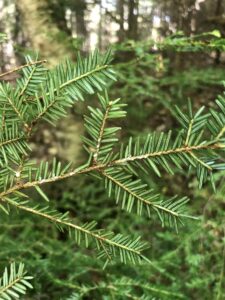What is Hemlock Wooly Adelgid?
Hemlock Woolly Adelgid (HWA) is an aphid-like insect native to Japan, China, and British Columbia, Canada. They first arrived in the eastern United States on nursery stock in the 1950s, and were first discovered in Nova Scotia in Yarmouth County in 2017.
While native to parts of Canada, HWA is an invasive, non-native species in Nova Scotia. HWA feeds on the nutrients and water storage cells at the base of Eastern Hemlock needles, leading to the decline and eventual death of hemlock trees. Hemlock mortality where HWA is present is over 95%, typically within 4 to 10 years of the adelgid’s arrival.
HWA is very small and difficult to see with the naked eye. It’s easiest to identify by the presence of the small, woolly egg sacs they create at the base of hemlock needs. They are most visible on the underside of hemlock branches in late fall, winter, and early spring.
Why is it important to protect hemlocks?
Eastern Hemlock trees are a key component of the Wabanaki-Acadian forest. Many species rely on them for food and habitat.
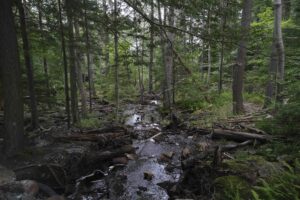
Photo credit: Bradley Watson.
As a foundational species, hemlocks can create their own environmental conditions and perform critical ecological functions. The dense, multi-layered canopies of Eastern Hemlock block out sunlight, offering wildlife a shady reprieve and regulating the temperature of the understory. They play an especially important role in stabilizing temperature and keeping streams cool. In the winter, hemlock forests offer wildlife important shelter from freezing temperatures because they trap warmth from the earth, and their dense canopies catch snow and freezing rain. The loss of the Eastern Hemlock would irrevocably change the composition and character of the Wabanaki-Acadian forest and have cascading effects on associated and hemlock-dependent species.
Hemlock trees also store a large amount of carbon due to their size and longevity (they can live to be over 400 years old!).
Impact of HWA in Nova Scotia
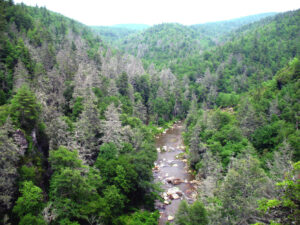
Hemlock woolly adelgid turned hemlock trees into characteristic “gray ghosts” in North Carolina’s Linville Gorge Wilderness, part of the Appalachian Mountains.(Credit: Steve Norman, U.S. Forest Service)
With no natural predator to control the population, HWA has devastated hemlock forests in southwest Nova Scotia since it was first discovered here in 2017. This invasive species is highly transmissible and is spreading rapidly. It has now been identified in nine Nova Scotia counties, most recently in Halifax Regional Municipality and Hants County in 2023.
In the southwestern-most parts of the province where HWA has been present for several years, hemlock trees are (by and large) completely dead and forming what are known “ghost woods.”
In central southwest Nova Scotia (near Kejimkujik National Park), HWA has caused significant defoliation, twig dieback, and tree loss. We’re on the road to losing hemlock trees in this region forever without rapid intervention.
At the current edge of where HWA is most newly arrived, in Hants County & Halifax Regional Municipality, we are not yet seeing significant impacts to the still-healthy forest. However, we are only a few years away from losing beautiful trees.
How has it impacted the Nova Scotia Nature Trust?
The Nature Trust is very fortunate to have significant stands of old-growth and mature hemlock forest on several of our Conservation Lands.
Nature Trust lands in Yarmouth County were some of the first to be impacted by HWA, before methods of intervention were available in Nova Scotia. We are monitoring the long-term ecological impact of this severe infestation and evaluating what it means for our conservation work going forward on these lands.
Hemlock forests on several of our Conservation Lands in Queens County and Annapolis County have been significantly impacted by HWA. The infestation level is moderate to severe, but thankfully these hemlocks can be saved if they receive treatment in the next 1-2 years.
HWA has also been found on Nature Trust properties in Hants County and (likely) Kings County. The infestation level is very low, and we have a great chance of saving these hemlock forests!
HWA has been identified on the following Nature Trust properties:
- Jack and Darlene Stone Conservation Lands
- Gillfillan Lake (site 5) Conservation Lands
- Acacia Valley Conservation Lands
- Luxtons Meadow Conservation Lands
- Cameron...
- Jack and Darlene Stone Conservation Lands
- Gillfillan Lake (site 5) Conservation Lands
- Acacia Valley Conservation Lands
- Luxtons Meadow Conservation Lands
- Cameron Lake Conservation Lands (all sites)
- St. Mary Bay Conservation Lands
- Ponhook Lake Conservation Lands
- Medway River Conservation Lands
- Knox Conservation Lands
- St. Croix (site 1) Conservation Lands
HWA is likely present or will be present in the near future:
- Medway River Conservation Lands
- Upper Pleasant River Conservation Lands
- Gold River Lake Conservation Lands
- North Mountain Woodlands Conservation Lands
- Wolfville...
- Medway River Conservation Lands
- Upper Pleasant River Conservation Lands
- Gold River Lake Conservation Lands
- North Mountain Woodlands Conservation Lands
- Wolfville Ridge Conservation Lands
- Wolfville Watershed Nature Preserve Conservation Lands
- St. Croix (site 2) Conservation Lands
- Meander River Conservation Lands
What has the Nature Trust been doing about HWA?
With the arrival of HWA in the province, the organizations that were concerned about or impacted by HWA (including the Nova Scotia Nature Trust) convened a working group to address the problem. The working group spent years researching, consulting groups in the northeastern United States about their own responses to HWA, and have now successfully implemented a provincial HWA Action Program to protect the highest priority old-growth hemlock stands in Nova Scotia.
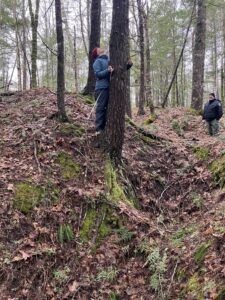
Stewardship staff marking trees for HWA treatment on Nature Trust land at St. Croix in 2023.
In 2023, the Nature Trust took our first steps to actively manage HWA on our Conservation Lands. Nature Trust staff conducted HWA priority assessments to understand the extent of hemlock forest on our properties and what impact HWA has had (if any), to determine which of our Conservation Lands should be prioritized for immediate treatment. We are now actively taking steps to treat and save the highest-priority hemlock stands under our protection, according to the most up-to-date research and approved practices.
Several of our properties in Queens and Annapolis County are being considered for HWA treatment under the provincial HWA Action Program.
The Nature Trust is also pursuing independent treatment of other priority sites not covered under this program. This treatment will begin in 2024. If you visit certain Nature Trust lands, you may notice flagging tape and aluminum tags on hemlock trees, indicating that they will be receiving HWA treatment this year.
We are also monitoring the spread of HWA across the province by setting up and regularly checking monitoring plots on properties with hemlock forests east of the “leading edge.” This will help us identify as quickly as possible when HWA reaches our properties.
How can I help prevent the spread of HWA?
HWA spreads naturally via wind, birds, and mammals, but also by humans through movement of wood products and on our clothing/footwear. To help reduce further spread of HWA, we encourage our supporters to adhere to some biological control practices when visiting Nature Trust properties with hemlock forests (if you know or suspect that HWA is present):
- Do not collect and move hemlock foliage/wood products
- Use a lint roller to remove potential crawlers from clothing, shoes, and backpacks
- Do not bring your pet into infested stands
- Launder all clothing prior to re-entering the field
- If possible, avoid visiting hemlock stands in other, uninfested areas for several days
HWA eggs hatch into nymphs known as “crawlers”, which is HWA’s only mobile phase. Crawlers can be easily spread and cause new areas of HWA infestation. If you are in a hemlock forest from early April to late August, please take extra care to follow the biological control practices listed above.
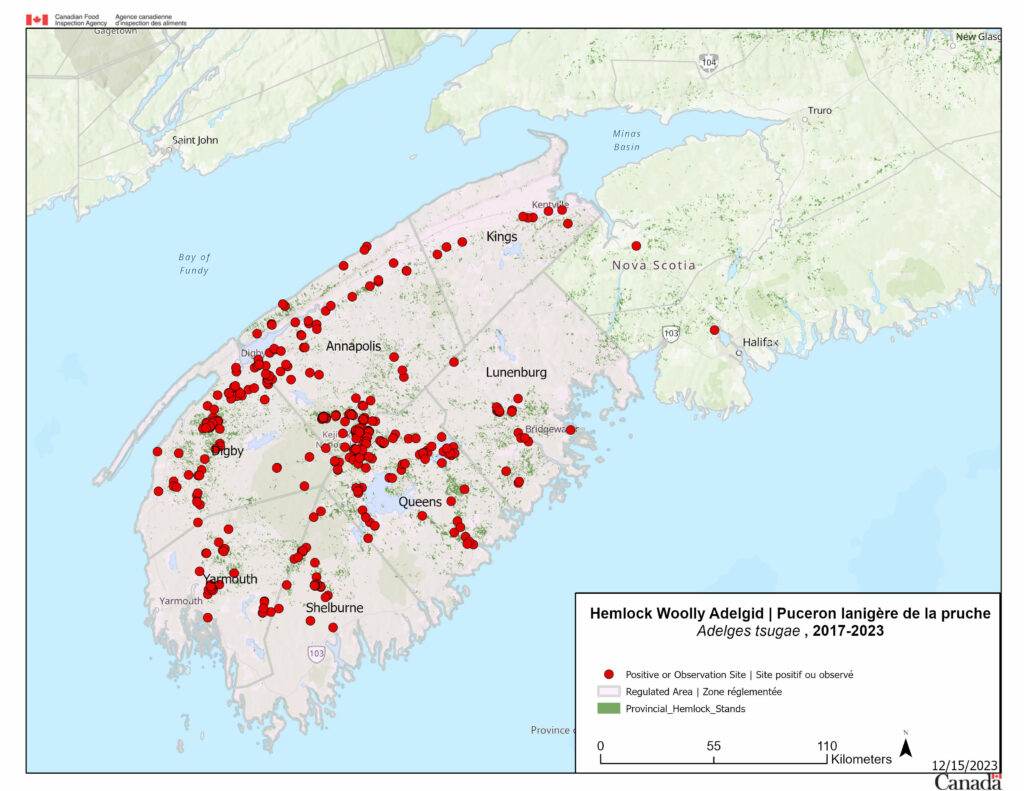
What should I do if I find HWA in a new area?
Do not collect branch samples or specimens; please take a photograph instead. It is best to photograph the underside of the hemlock branch where the woolly egg sacs are more visible. This can help better gauge HWA infestation level.
Record your location using GPS or mobile device.
Report your sighting on iNaturalist. Observation of HWA are tracked by the Canadian Food Inspection Agency.
If you don’t use iNaturalist, you can also report your sighting to Ron Neville with the CFIA.
If the sighting is on Nature Trust Lands, please also send picture and location pin to riki.kerbrat@nsnt.ca.
How can I manage HWA on my own land?
Managing HWA is an incredible tricky and expensive process. We encourage everyone to visit the ‘What are my options?’ page on the Nova Scotia Hemlock Initiative website, which details the management options available to individual landowners.
If you are interested in treating hemlock on your own property, you can also contact your local Department of Natural Resources and Renewables office to find out more about what that might entail.
For more information, please visit the Nova Scotia Hemlock Initiative website or this Government of Canada fact sheet.
How can I help the Nature Trust?
Reporting any sightings of HWA and adopting the biocontrol practices described above are the best things you can do to help protect the hemlocks under our care.
We do not currently have a program for volunteers to help with marking, treatment, or other direct HWA protection. As we continue to develop our monitoring and treatment programs, we will be evaluating how volunteers may be able to help in the future.
In the meantime, if you would like to become in involved in the fight against HWA, please consider becoming a Hemlock Hero with Medway Community Forest Cooperation.

